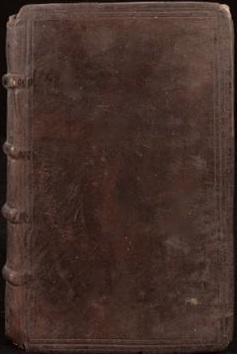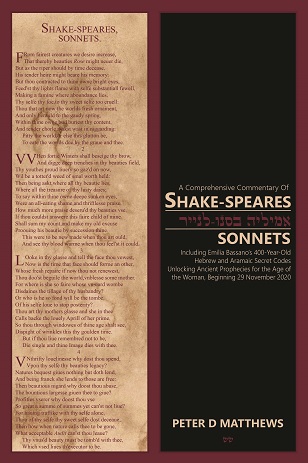To download a copy of this academic paper in pdf format, please click here: PAPER -Antonio Bassano’s 1544 Serfer ha-Refu’ot (Book of Remedies)
After publishing ‘Shakespeare Exhumed: The Bassano Chronicles’ I was contacted by a descendant of Antonio Bassano. He told me he had a book that would be of interest to me. I did not understand the significance of Antonio Bassano’s 1544 Sefer ha-Refu’ot (Book of Remedies) until I began translating the Latin, Hebrew, Aramaic and Greek texts.
The book exhibits Jewish natural healing remedies using substances of the earth, such as honey, wine, balsam, mandrake, date palm, numerous herbs, roots, minerals, and even stones – all of which were used throughout the Shakespearean works. These ancient remedies can be traced back to the Essenes of Bashan (Bassan), Qumran, Nazareth and Jerusalem during the Hasmonean Dynasty, with some even dating back to King Hezekiah. There are specific references to the angel ‘Azarie’ as the Archangel ‘Raphael’ who is noted as being ‘in charge of healing the wounds of the sons of men’ , which was taken from the Book of Enoch and further references from the Book of Jubilees. This angel is also cited as the ‘spirit of health’ in Act 4, Scene 1, of Hamlet.
The interesting connection to the First Folio is the binding technique and the initials of a ‘W.W.’ with the date of ‘4 Apr. 1624’ penned on the inside cover page. This suggests the book was bound by a ‘W.W.’ on 4th April 1624. The tattered pages are creased as though they were previously held together with a single string in the middle just as the First Folio was prior to binding. The leather on the Sefer ha-Refu’ot is strikingly similar to that of the Bodleian copy of the First Folio. It was bound with a dark brown chocolate fine calfskin leather with uniform grain laid grain side out, just as was done with the First Folio. The diagonal hatching blind-tooled on the edge of the spine of the Sefer ha-Refu’ot tend to suggest the ‘W.W.’ may be William Wildgoose because both books contain blind-tooled inboard bindings of brown calfskin over pulp boards with the same endleaf craftsmanship.
The condition of the leather on the Sefer ha-Refu’ot is considerably better than the First Folio. They both have similar damage to the leather cover that is consistent with the age. However, both front and rear hinges to the Sefer ha-Refu’ot are damaged. The fact that the First Folio was bound with a different and more expensive darker brown calfskin leather than other books bound by Wildgoose tends to suggest a deal was done with the Bassano family for binding their family book of remedies in exchange for the supply of fine dark brown chocolate calfskin. They were exporters of fine chocolate leather.
In Act 1, Scene 3 of All’s Well that Ends Well, we find the mention of a Book of Remedies left to Helena:
I will tell truth, by grace it selfe I sweare:
You know my Father left me some prescriptions
Of rare and prou’d effects, such as his reading
And manifest experience, had collected
For generall soueraigntie: and that he wil’d me
In heedefull’st reseruation to bestow them,
As notes, whose faculties inclusiue were,
More then they were in note: Amongst the rest,
There is a remedie, approu’d, set downe,
To cure the desperate languishings whereof
The King is render’d lost. (F1, AWW 1.3.553-63.)
Hellena tells the Countess that her father left her some prescriptions of rare and proud effects, and later Lafeu speaks of medicine that is able to breathe life into a stone. We find the King of France in Act 5, Scene 3 speaking of tincture, multiplying medicine, and natures mysteries. Clearly the author was referring to Antonio Bassano’s 1544 ‘Book of Remedies’ that contains proven prescriptions, consisting of various elements of nature, particularly tinctures, electuaries, and elixirs (multiplying medicines), with a specific notation that states that a number of healing remedies were ‘proven on Henry VIII’.
All’s Well That Ends Well was no doubt penned by Emilia Bassano/Lanier as it exhibits her time as servant of the Countess Susan Bertie. It is quite plausible that Emilia possessed a copy of her family’s ‘Book of Remedies’. There is an inscription in a faint handwriting of a quill pen of ‘A.Bassan’ on the inside cover page of Sefer ha-Refu’ot that appears to have been added at a later date, thus the original book may have been printed for each first generation member of the Bassano family so that their remedies could be passed down to their descendants.
I am only aware of one single surviving copy of the Sefer ha-Refu’ot at this stage. Whilst the owner of this book has provided me a copy of book to translate and publish, and use as a cross reference to my book ‘Genesis the Shakespearean Works’, he has prevented me from publishing the original images. I am also prevented from revealing the owner’s name, address, or anything about them, merely because this book will hold significant value and the owner is concerned of being bombarded by people wanting to buy the book. He has no intention of selling it. He believes once it is ‘out there’ in the public domain, the original book will become a major risk to keep secure against thieves.
I am not even permitted to share it with other family members! This to me is out of sync with the desire of the author of this book. As a philosopher, I believe the original text should be published so that scholars may have the opportunity to study the text, the handwriting, and be able to teach it in universities around the world. To that end, I have shared my displeasure with the owner. I must stop myself there, otherwise I might offend the owner and he may withdraw his consent to translate and publish an English version of the book.
That being the case, I am appealing to others around the world: if you possess a copy of the Bassano’s 1544 Sefer ha-Refu’ot, please contact me as a matter of urgently. If Emilia did in fact write All’s Well that Ends Well, she must have possessed a copy or had access to the family’s Sefer ha-Refu’ot. I would like to confirm my hypothesis: that more than one copy of this book may well exist. To be up front, my desire is to share it with the world. I will not publish your name or address. All I want is to share the original text with academics and students alike around the world. Please contact me if you possess a copy or know of a surviving copy in existence today?
© 2015 Dr Peter D Matthews PhD
For the full story, look out for ‘Genesis of the Shakespearean Works’ on bookshelves in 2016.



